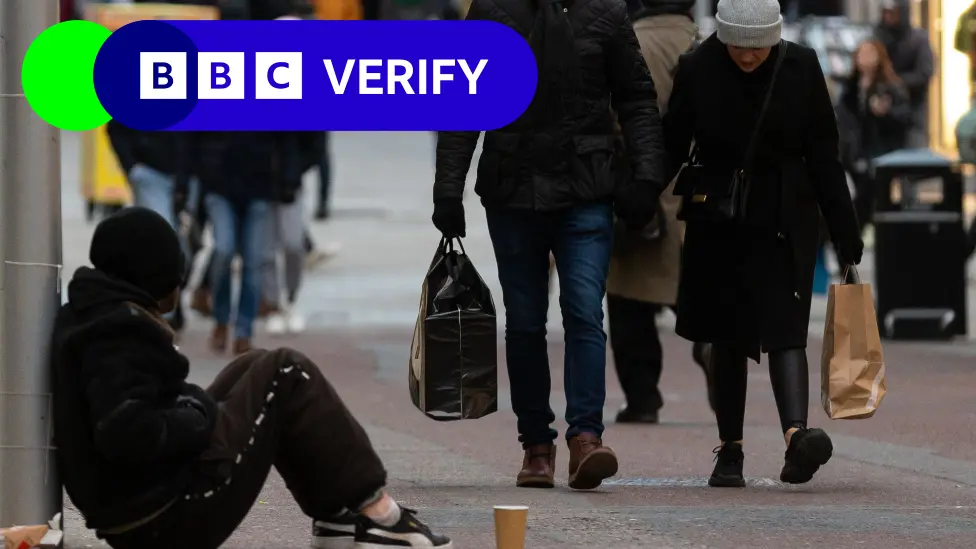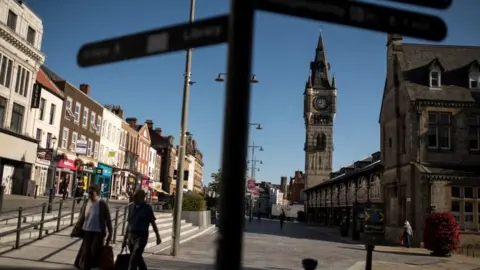What is levelling up and who is it helping?
 EPA
EPAMPs have criticised levelling up schemes after finding that only 10% of the promised funding has been spent so far.
The Public Accounts Committee also criticised a lack of transparency in how the money was allocated.
What is levelling up?
Levelling up is a government policy to reduce inequality based on where people live.
It was a big slogan for the Conservatives in the 2019 election and was in the party's manifesto.
Rishi Sunak says its aim is "to create jobs, drive growth, and make sure that people feel enormous pride in the places that they call home".
Who has received funding?
The Levelling Up Fund awarded £1.7bn to projects in October 2021, £2.1bn in January 2023 and another £1.1bn in November 2023.

The North West of England received the most money overall, followed by Yorkshire and the Humber.
Questions were raised when the South East of England was awarded the second largest amount of funding in the second round.
The government highlighted funding per head of the population. If you look at the funding awards this way, Wales comes out on top and the North of England does better than the South of England.

The Public Accounts Committee said that only £3.7bn had been allocated to local authorities by December 2023, while councils had been able to spend only £1.24bn as of Sept 2023.
It said the first round of levelling up funding was awarded to "shovel-ready" projects that were due to be completed in March, but 60 out of 71 (85%) have had to extend their deadlines, with further delays in other schemes said to be "likely".
How fair is the process?
Areas were invited to bid for investment in transport, cultural, town centre and regeneration projects.
Local MPs were allowed to give their formal support to two bids before the proposals were judged by officials from the Treasury, Levelling Up Department and Department for Transport.
Assessing how fair this is, is not straightforward. Some projects - such as transport - may spread across several constituencies, represented by MPs from different parties.
For the projects that can be allocated to a single party, we can say that more money was allocated to Conservative constituencies than to Labour ones. But there are significantly more Conservative ones.
BBC analysis of the second round of funding found:
- 52% of successful bids that can be allocated to a party were in Conservative constituencies (the Conservatives won 56% of seats in the Commons in 2019)
- 24% of them were in Labour areas (Labour won 31% of the seats in 2019)
- Projects in Tory constituencies were awarded a total of £1.21bn, compared with £471m in Labour ones.
- There was one successful bid in a Lib Dem constituency, seven for the SNP, five for the DUP, three for Sinn Fein, and one each for the Alliance Party and Plaid Cymru.
Areas have also been competing for money under the government's Towns Fund. In that contest, of the 56 constituencies that won, 47 had Conservative MPs.
What about deprived areas?
On the second round of funding, Rishi Sunak said: "two thirds of all the levelling up funding is going to the most deprived parts of our country".
BBC analysis shows that using the government's index of multiple deprivation, which is the usual measure, in the second round about 57% of England's funding went to the areas with the highest deprivation, down from 69% in the first round.
That analysis excludes a small number of awards that were given to areas covering multiple local authorities.
We asked the Levelling Up department about Mr Sunak's claim. It said it was not based on the government's index of multiple deprivation but was instead based on measures involving productivity, employment, vacancy rates, lack of skills and transport links.
What have critics said?
Labour said the money awarded was dwarfed by the cuts to local authority funding since 2010, with Alex Norris telling MPs: "the government have nicked a tenner from our wallets and expect us to be grateful for getting less than two quid back."
The Institute for Fiscal Studies found that between 2009-10 and 2019-20, English councils' non-education funding per resident had fallen by almost a quarter, after adjusting for rising prices.
The Institute for Government found that councils in the most deprived areas had been worst hit because they were the most reliant on central government funding.
Andy Street, the Conservative mayor of the West Midlands criticised the Levelling Up funding process as being part of Whitehall's "broken begging bowl culture".
He suggested the money would have been allocated better by local decision-makers than civil servants in London.
 Getty Images
Getty ImagesWhat is the government looking at apart from funding?
- Having 22,000 civil servants based outside London by the end of the decade, with a target for 25% of roles to be outside London by 2025
- The government wants to level up skills with an extra £126m announced in March 2021 to fund work placements and training for 16 to 24-year-olds in England
- Locations for eight freeports have been chosen in England, with two planned in Scotland and two in Wales.


